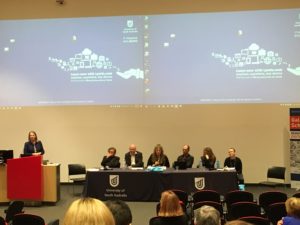aaDH Conference 2018: Making Connections
Australasia Association for Digital Humanities (aaDH) Biennial Conference
September 25-27, 2018
University of South Australia (Adelaide, Australia)
The theme of this biennial aaDH conference was “Making Connections”, and this was effectively woven through many of the presentations (and not in a way that was overly corny). Compared to the last conference, I noticed the theme of a need to upskill students (both for changing workforce needs and research needs) kept popping up, so it appears this is still a concern that is not being adequately addressed. There was also more discussion of mobile apps and issues of ethics. The conference got off to a great start with beaded name badges that help provide revenue to women who have been trafficked, and everyone was talking about it and wondering why every conference doesn’t go down this track. Overall, I found the presentations interesting and informative and felt inspired to continue along the DH track. What follows are some of my notes on ideas and resources and avenues for further exploration. The hashtag for the conference was #DHA2018, but some of the frequent Twitter posters were at an archives conference so the feed was not as active this time around.
Day 1 — September 25, 2018
Dennis Del Favero – AI and Advanced Creativity: An Emerging Horizon
Favero said Stanley Kubrick’s 2001: A Space Odyssey (which he hoped everyone had seen) has shaped how we see AI and its relationship with humans. He provided several examples to illustrate his points about the intersection of AI and creativity. Discussing Flora Petrinsularis, he said the database is the new medium, defining a database as data structured in a way that can be retrieved, and the machine enables the human to organize and interpret the data. With T. Visionarium, it has a database of films and you can select say, Sandra Bullock playing different roles simultaneously (it can show around 200 films at a time) or choose a color like orange to see orange scenes, and these will be displayed in the room. With mARChive, the idea of co-agency allows for machine autonomy rather than just reflecting human desires. The Scenario example featured a creepy baby assembled by users with headsets and black [later said to be dark gray] AI figures trying to stop them. With Nebula, you make dots into a sphere and topography of worlds. With iBauprobe, you can design sets with the help of 3D model and AI, looking at things such as configuration of angles, line of sight, etc. Lighting is one of most difficult things to calculate; AI can show what it will look like with different lighting combinations.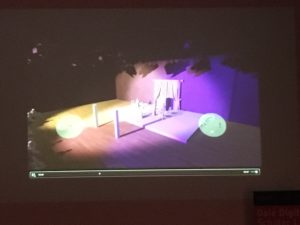
He noted that Manuel DeLanda was writing back in 1919 that even rocks and mountains that we see as stable are actually changing and breaking down, just at a slower rate than biomass.
In the Q&A, he said that we need to become coders ourselves; maybe the primary or complementary literacy is coding; need to democratize it. He said half of his PhDs now are coders even though working in art/humanities areas. There was a question about stark race differences in white and black figures, and he said they’re actually shades of gray but yes, this is a problem. He said his interest in AI is its experimental use in art and how that can be translated to other areas. It shouldn’t be a castle for elite (like Mark Zuckerberg) but available to everyone, but we need computational literacy to enable this.
Panel: New Directions in DH Infrastructure: Adventures in Collaboration and Scale
Del Favero
Favero discussed how STEM have traditionally used numbers in understanding data and things; we could bring our skills in visualizing and imagery to their disciplines (ex. In one project the Arts perspective was able to see climate patterns that the numbers didn’t reveal; now an Arts perspective is part of project.) PhDs traditionally work alone/not in teams but this is not viable going forward; need innovative culture where people work together in teams. The one-dimensional primary and secondary education doesn’t have computational literacy. One can be seduced by lure of STEMification (even in STEAM – Arts often evaporates in this equation).
Hamish Maxwell-Stewart
Maxwell-Steward said we need a way of seeing datasets and databases as journal articles/publications and allowing people to access them and see who was involved. Gene sequencing is easy; the cultural context, etc. is more complicated and that’s where Humanities comes in. He would like to be teaching digital and visualization skills to history students in the very near future. He offered an example of how a well-liked presentation recently was, somewhat surprisingly, by an undergraduate math student who was given a bunch of data.
Tully Barnett
Barnett discussed how we need to understand digitization as a cultural practice not just a technical thing, and we need to talk more about labor behind digitization projects. Infrastructure in humanities is people-focused. Longitudinal value has to be recognized (value goes beyond funding cycles). She mentioned the Algorithms of Oppression book and how infrastructure catalyzes, according to scholar Deb Verhoven.
Bill Pascoe
Pascoe also mentioned Verhoven’s work. He suggested smaller grants and much more rapid funding cycle (big, year-long ones are too slow for IT and mean only small groups of people get to do DH projects). The current situation can be self-defeating and miserly where people don’t share, and it needs to change.
Rachel Hendery
Hendery said that what makes people angry in seeing government funding going to things is seeing new buildings and yet no investment in people (staff, casual, etc.). She mainly needs basic infrastructure like a computer and library. She suggested we first think about community we want to build, not the tools or system (sometimes those turn out to be white elephants anyway). We need to make ‘3rd space’ workers more visible (ex: big grants that public complain about that seem excessive, but actually going to a postdoc, PhD scholarship, etc., and we need to make that job creation more visible).
Katherine Bode
Bode suggested that perhaps universities aren’t doing as good a job as GLAM (Galleries, Libraries, Archives, and Museums) at communicating with the public via digital technology and infrastructure. She said we need to put money into open access publishing; let’s not look to publishing companies to solve our problems. We also need more skill sharing and data sharing.
Q&A
It was discussed that we think we know how to tell stories, but actually we could get better at showing impact. Someone asked is there a tension between coding and how it chunks and categorizes information and the humanities? The panel responded that no one should be doing coding if they don’t critically reflect. We need to be infiltrating STEM and showing STEM students how to critically reflect. It is hard to critique as an outsider. Also, we need to remember that all languages are coding too. We can think about how do we share coding and bring our understanding to STEM. Think of collaboration as something to do at the beginning, rather than the end. Someone said it was great to see the theme of inextricability of infrastructure and people, but historically DH is male and white; how do we ensure greater diversity and inclusion? It was discussed that one thing we need to do is to recognize all involved with DH projects; not just puffed-up DH researchers but also women of color (for example in Google Books digitization).
Session on Making, Learning, Exploring
Simon Musgrave – DH and Disciplinary Frontiers
Musgrave discussed how when applying computational methods to literary texts, we can ask whether semantic/conceptual patterns in the texts support traditional close reading. He said not all of his DH work is interdisciplinary, but that doesn’t mean it’s not DH. Research is driven by creative tension that comes from unambiguity of the digital with inherent ambiguity of humanities, and he clarified this as meaning that once data becomes digitized and structured, there are limitations on it so in general it allows for much less ambiguity than humanities content broadly. He said he could write sole-authored papers, but he doesn’t like to anymore. He acknowledged that we’re often not doing/dealing with research questions that computer scientists find interesting; this raises the question: should we try to change that or just get technical people who code? Another question to think about is when are we ‘bilinguals’?
Jeanne-Marie Viljoen – Mediating between the physical and the digital with a location-based mobile learning game
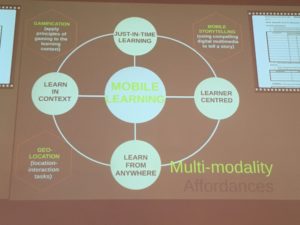 Viljoen said she is always looking for ways to engage students with digital media. The class she was discussing was called English for Academic Use in Australia and designed for multilingual students, new arrivals in Adelaide. Many come from tech-savvy backgrounds in Asia but are used to more passive pedagogy styles and are more likely to drop out because of problems socializing. Her mobile learning game introduces students to local culture and history, including things like street art and statues. It aims to merge the digital and natural world into a virtual experience. It uses digital design and evocation of hearing, touch, taste, smell, and feelings though the visual. For example: “run your hands along smooth bronze possum”. She tried to rely on sound and touch rather than the English language. It was built in Mobile Learning Academy.
Viljoen said she is always looking for ways to engage students with digital media. The class she was discussing was called English for Academic Use in Australia and designed for multilingual students, new arrivals in Adelaide. Many come from tech-savvy backgrounds in Asia but are used to more passive pedagogy styles and are more likely to drop out because of problems socializing. Her mobile learning game introduces students to local culture and history, including things like street art and statues. It aims to merge the digital and natural world into a virtual experience. It uses digital design and evocation of hearing, touch, taste, smell, and feelings though the visual. For example: “run your hands along smooth bronze possum”. She tried to rely on sound and touch rather than the English language. It was built in Mobile Learning Academy.
Benjamin Matthews – Teaching DH for Creative Industries: Immersion and Making
bit.ly/DHA2018-BJM
Matthews thinks Creative Industries students will benefit from DH literacies. He discussed a 1st year core subject called “What is Creativity” and gave the example of asking students what will Newcastle be like in 2049? This encourages them to use history to inform their vision of the future. He worked to give them ‘skin in the game’ by making them have an exhibit at the end, and this seemed to work to motivate them.
Maya Dodd – Collaboration in the DH Classroom
 Dodd gave the background context of her university first, saying that India was moving from a British model to a more liberal education model so students were not locked into a major, and this is a good opportunity for DH. She said her work on digitizing copies of an official report that was being suppressed showed her the power in these kinds of projects (see Southasianculture.wordpress.com and Publicarchives.wordpress.com).
Dodd gave the background context of her university first, saying that India was moving from a British model to a more liberal education model so students were not locked into a major, and this is a good opportunity for DH. She said her work on digitizing copies of an official report that was being suppressed showed her the power in these kinds of projects (see Southasianculture.wordpress.com and Publicarchives.wordpress.com).
She said usually research is done at higher levels (i.e., postgrads or faculty), but the faculty are having undergrads do research because there is such a need, and it can create timely projects. She discussed some examples of interesting student projects, such as an Omeka project on student protests, slam poetry as a vehicle for student voices, and children’s literature from India. She used documentation on assessing DH projects from others; like with Arts projects, it’s incremental (looking at factors like rigor).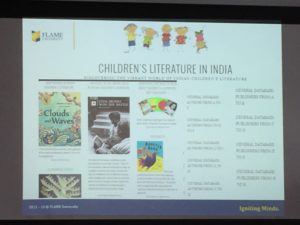
Kunjika Pathak and Anjali Chandawarkar – The Garba Archives
Pathak, who is one of Dodd’s undergraduate students, discussed her joint project on the community art form of garba (Thegarbaarchives.wixsite.com/thegarbaarchives). She and Chandawarkar translated songs and created an audio file for an archive. They discovered limitations with doing the project, which included issues with living cultures such as caste, gender, etc. She said she saw it as a way of connecting with her cultural heritage, especially since she knows she is immersed in Western pop culture a lot of the time. She also realized how little digital documentation there is for these kinds of things in India. As a side note, she said most of her English class is women and there are some really tech-savvy women, and they were able to assist others who were not as capable.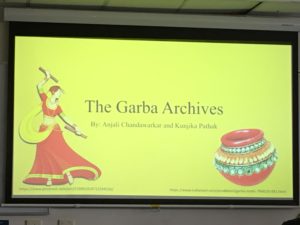
Birds of a Feather Session: Teaching DH
Simon Musgrave explained how a DH course at Monash University worked and some of the learnings from running it. They decided that all assessed work had to be done on a WordPress account, and they assumed nothing (for knowledge on the part of students). Students had to buy their own domain, but this was cheaper than buying a textbook. One issue was that some were getting spam because their details were on WHOIS (they had to use the non-free version of WordPress because they needed plugins), and this shows how little awareness students can have of these kinds of website issues. Instructors tried to run ‘place’ through all content, and this theme is easier with digital technology. They also asked students to draw maps to document campus without tech (unplugged pedagogy). Rather than using Moodle, then, they used an outside domain of their own: Monashdh.xyz.
Tips from the session included using Bigg’s SOLO taxonomy instead of Bloom’s, which is a bit dated, looking at how to get students to justify their use of methods rather than just cherry-picking info, and potentially setting students up with a dataset which has things they can stumble across (design, etc.). We worked on designing learning outcomes in groups for a sample DH day workshop, which was a valuable exercise.
Day 2 — September 27, 2018
Day 2 kicked off with a session where the continually evolving area of data visualization was explored in some interesting ways.
Session on Data Analysis and Visualization
Vejune Zemaityte in “Data-driven Cinema Studies” discussed her work with Deb Verhoven on the big data in film available from Kinomatics.com, where they are analyzing the distribution of 3,000 films across 40 countries. Monika Bednarek in “Discourse of Diabetes in Australian News Media: A Corpus Approach” provided three paper copy handouts [this is so rare nowadays!] about how diabetes is discussed in the Australian media and how she used Wordsmith, a corpus linguistics tool. She recommended Antconc if you want a free version that is still powerful. Helen Caple in “Introducing a New Visualization Tool: Kaleidographic” talked about this tool that is freely available and lets you has as many or as few variables in your spreadsheet as you want. She said after you prepare your data and load it into the builder, the data is saved to a zip file for you and isn’t kept on the tool’s end, which addressed some privacy concerns. 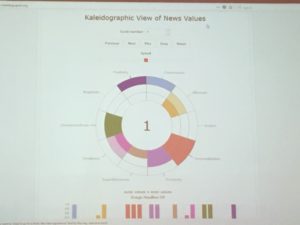 Penelope Aitken and Susan Luckman’s “Adding Structural Value to Cultural Value: A Case Study of APO and UniSA’s New Cultural Policy and Creative Industries Collection” explored apo.org.au, which was established in 2002 and is both a database and alert service. Aitken said the government is the biggest audience and that policy makers tend not to read journal articles. Therefore, it is ‘gold’ if you put up something they are going to read, like a two-page executive summary of your research. Luckman discussed a current ARC LIEF Project to enhance collections. They are seeking ideas for how to get people to use collections, such as perhaps a competition, how to engage end-users as co-creators/editors of meta-data, and how to gain feedback and a review of the content. She encouraged the audience to join APO and contribute to the site.
Penelope Aitken and Susan Luckman’s “Adding Structural Value to Cultural Value: A Case Study of APO and UniSA’s New Cultural Policy and Creative Industries Collection” explored apo.org.au, which was established in 2002 and is both a database and alert service. Aitken said the government is the biggest audience and that policy makers tend not to read journal articles. Therefore, it is ‘gold’ if you put up something they are going to read, like a two-page executive summary of your research. Luckman discussed a current ARC LIEF Project to enhance collections. They are seeking ideas for how to get people to use collections, such as perhaps a competition, how to engage end-users as co-creators/editors of meta-data, and how to gain feedback and a review of the content. She encouraged the audience to join APO and contribute to the site.
Jean Burgess – What’s Next for Social Media Research? Digital Methods and Ethics after the API Apocalypse
Burgess discussed Digital Methods by Richard Rogers (2013) and made a joke about pie charts being very science-y, an idea which was played off in later tweets. She said we need shared dynamic infrastructure to support datasets, rather than ad-hoc ones that are only available on a grant-by-grant basis (ex. through LIEF). She mentioned AlgorithmWatch, algorithm audits, a data donation project, and ‘civil disobedience’ through data scraping on a platform like Instagram through ‘Instagrab’. She asked whether our institutions have the ability to back us in these risky activities. In discussing the creation of a timeline to document changes in Twitter, she gave a shout-out to Timeline.JS tool. One question concerned whether academics can use the public internet defense to argue for being able to scrape and interrogate this data even though or because companies are private.
Mahendra Mahey – Building Better ‘Library Labs’
Mahey’s presentation was an interesting whirlwind tour of some of the British Library Labs’ projects and its vision for supporting access to its collections. He said only 3% of the physical collections are digitized, and that they used to rely on government funding but are increasingly reliant on private funders and corporate funding. He reiterated that if you want to set up a lab, you have to go out and talk to people. And one of the most important things for collections is, do you have a real person at the library who can answer questions about it. Their Digital Research Support is able to offer 5 days of support per project. There are over 1 billion views of British Lab projects. An early lesson was that services that allow useful exploration of cultural heritage data are rare! He said the role as a national library should be to find a way to support everyone who wants to use the digital collections anywhere in the world.
One project had them using OCR to ‘cut’ images from digitized books and use algorithms productively (see “Peeking behind the curtain of the Mechanical Curator”), and they discovered it did better with female faces because there seemed to be fewer obstacles like beards. Another project had them create the provocation mechanicalcurator.tumblr.com to post images every 30 minutes and put the images on Flickr Commons. But ‘real innovation breaks infrastructure’ and the IT team was annoyed that servers were slowing because so many people were clicking the links to the lab’s services on Flickr Commons images. The Victorian Meme Machine was also popular. One interesting thing about the taggers behind digitization and categorizing is that they may not be whom you’d expect. One of their most prolific ones is an elderly bed-ridden man in LA who has tagged over 45,000 images!
They are currently working on a ‘cookbook’ to help guide national, state, university, or public libraries that want or have a lab (if you want to help, send him your email). One version of the cookbook will be open-access, and there will also be a printed version (coffee-table book) that you can buy that will fund travel bursaries. Slides available: https://goo.gl/xNwrHY
Organize and Digital Session
Renee Dixson – Skullbook: A Bone Library of 3D Digital Models of Animal Crania
Dixson discussed 3D model-making and said that part of the purpose was to provide employability skills to students for the future, because employers expect digital skills. It appeared there were two ways of making them: either through 3D scanning or photogrammetry. Two examples were passed around so the audience could hold and compare them. 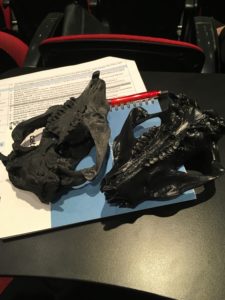
Mapping Transformation Session
Angus Veitch – Mapping Last Century’s News: Constructing a Geo-Thematic Index of the Brisbane Courier
Veitch discussed his research into mapping information from newspapers, available at www.oncewasacreek.org. He created transparent overlays with old maps on Google Maps and explained how words on maps can be just as interesting as the maps themselves because they can show what the landscape meant to people at other points in time. He said he used Knime rather than R or Python to acquire and analyze data, and it ended up being a shortcut to learning coding. He used LDA to do geoparsing and figure out which place words go together (what he calls geotopics).
Emotion, Memory and Experience Session
Tehri Hurmikko-Fuller – Tweet, Death and Rock’n’Roll: Social Media Mourning on Twitter and Sina Weibo
Hurmikko-Fuller discussed the project that she worked on with her Chinese student which was able to analyze how people mourn on social media sites such as Twitter and Sina Weibo (Chinese version of Twitter). She said they noticed that Twitter users were trying to connect with and mourn with the widow of the Linkin Park band member who had died, whereas Weibo users made posts that were more emotionally distant and about sharing news. They determined that information cascade was not the cause but herd behavior was. She said they are now collecting data on social media mourning of the burning down of the Rio Museum, which is interesting because it is not a person but a GLAM institution.
Rachel Neaman – Making Connections in a Digital World
 Neaman gave a public lecture at the university in the evening to a quite large, packed-out lecture theater. She said many of us find digital connectivity astounding, but young people take it for granted. She said her background was not as a technologist but as someone who studied languages. She mentioned the 4th Industrial Revolution term being coined in 2016 and that the book Robot-Proof (2017) by a U.S. academic, Joseph E. Aoun, talked about the importance of ‘soft skills’. This book talked about three types of literacy (tech, data, and human) and coined the term humanics. She offered an anecdote about how Amazon’s Alexa digital assistant in people’s houses heard a comment over the radio about a girl ordering a dollhouse and ordered doll’s houses for them too.
Neaman gave a public lecture at the university in the evening to a quite large, packed-out lecture theater. She said many of us find digital connectivity astounding, but young people take it for granted. She said her background was not as a technologist but as someone who studied languages. She mentioned the 4th Industrial Revolution term being coined in 2016 and that the book Robot-Proof (2017) by a U.S. academic, Joseph E. Aoun, talked about the importance of ‘soft skills’. This book talked about three types of literacy (tech, data, and human) and coined the term humanics. She offered an anecdote about how Amazon’s Alexa digital assistant in people’s houses heard a comment over the radio about a girl ordering a dollhouse and ordered doll’s houses for them too.
Neaman said digital is no longer just for IT and technical teams, and vice versa; those teams need to know more about customers’ needs and business side of things. Alongside an image of sheep, she told the audience that leadership is not about following the crowd but asking the right questions. I was very disappointed to hear her use the terms ‘man’ and ‘mankind’ just as she discussed the need for more women and diversity in the industry. 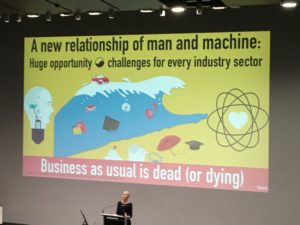 She mentioned that Honeybot had done a Women in Tech report and produced an index on women in OECD countries. There was an interesting quote from Professor Dame Wendy Hall about diversity: “We cannot allow our world to be organised by algorithms whose creators are dominated by one gender, ethnicity, age, or culture”.
She mentioned that Honeybot had done a Women in Tech report and produced an index on women in OECD countries. There was an interesting quote from Professor Dame Wendy Hall about diversity: “We cannot allow our world to be organised by algorithms whose creators are dominated by one gender, ethnicity, age, or culture”.
Neaman did try to clarify that AI is more of sophisticated computational statistics than advanced robots, but I don’t know that that message really made it through based on audience questions. She noted that 21% of adults in the UK lack the five essential digital skills defined as digital literacy. Even though Australia doesn’t have the same measure, around 10% aren’t online as shown by the digital inclusion index. She said today it’s more about outcomes than technical skills and we need life-long learning. Few schools formally teach these skills, but it’s not just for kids in schools; we need future-proofed policies so we feel empowered and able to thrive. She mentioned the World Economic Forum’s 2022 Skills Outlook, which has columns for growing and declining, and the 2018 Edelman Trust Barometer.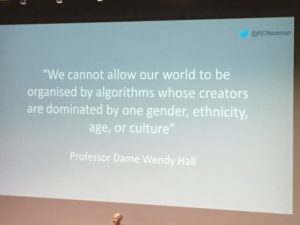
There was a question about the difference between digital competency and literacy. Neaman responded by saying that teaching about these topics needs to be mainstream from the very beginning of kids’ schooling, and that it is disappointing to be still having this conversation in 2018. I didn’t agree that reading and writing won’t be needed in the future due to podcasts and YouTube becoming more dominant. There was a question about whether AI will be able to have or tap into other ways of knowing (i.e. indigenous knowledge) in the future, and this question signaled to me that the audience would have benefited from a clearer definition of AI.
Day 3 — September 28, 2018
New Learning and Collaboration Models Session
Roger Edmonds and Richard McInnes – Enhancing Humanities Learning Experiences with Location-Based Mobile Learning Games
Edmonds discussed the expansion of games from an initial Business & Society course to 13 disciplines. Originally, students had to go out to discover their city in this course with pen and paper in all sorts of weather and didn’t like it. Now there are 193 games that have been played almost 3000 times. The ‘Torrens Walkabout’ was the same as the one Jeanne-Marie Viljoen talked about. It is not just a tour but interactive, push-pull, and about a story/narrative. A game was also created for the Aboriginal Cultures gallery in the South Australia Museum using a floor plan rather than Google Maps. Edmonds said that just being able to create a game is a really rewarding and engaging experience for the students, and it built their ICT capability and capacity. See bit.ly/2QymiZ6 for slides and Pedago.online for more information on the project.
Kara Kennedy and Jakob Kristensen – Exploring the Impact of Digital Humanities on Students’ Engagement with Technology
We presented on our study that explores how Digital Humanities tools and methods in undergraduate courses are impacting students, especially in their engagement with digital technology, and how DH is affecting women in particular. We presented the context and reasons for the study, including the gender gap in STEM and the limited data on what undergraduates think about DH and how it impacts them. We gave an overview of the methodology and sample questions, and asked for people to get in touch if they have students who could be interviewed.
Philip Marriott – Building Collaborative Real-Time Research Tools for Mobile Devices
Marriott began with the context, an advanced web design course where students had been using WordPress, which was pretty uninspiring. He suggested mobile phone web-based software instead and this ended up being more interesting of a project for them. Fifty of the 60 students were women, not from a STEM background, who already had basic idea of HTML, CSS, and PHP that he’d taught them earlier. They had great ideas but no mechanism for realizing them/doing anything with them, and there were lots of barriers to overcome. As a side note, he said it was helpful that Google allows you to use all their stuff if you sign up as a developer. He encouraged and empowered the students by telling them that anything you see out there on the web, you can do it too. It turned out that they were happy to use code as a way to do what they wanted.
Julian Thomas – DH and Digital Inequalities: Current State, Problems and Prospects
Thomas is head of the Digital Inclusion Index and defined digital inequality as an uneven distribution of digital skills, infrastructures, and resources. It is a problem because these are increasingly important for participation in contemporary economic, social, and civic life. Interestingly, he noted that young people are not the future of Australia – old people are! –according to the changing demographics. We assume mobile media is associated with sophisticated, intensive use, but that’s not necessarily the case. Their study showed that single parents, people with disabilities, Indigenous people, and other marginalized groups were likely to use mobile media more. He said we need to think hard about the ramifications of the next wave of automation. In the Q&A, Rachel Neaman asked if there were a standard for measuring digital ability (the UK, for example, has 5 prongs). Thomas said there isn’t the same thing as the UK, and that it’s nice to have international comparisons, but the cultural and human geography is different here in Australia, so he thinks there is need for Australia-specific measurements about digital strategies and inclusion. He acknowledged that yes, North America and Europe also have a divide between the country and city, but there are still unique geographies in Australia. He mentioned Broadband for the Bush as working in the space of digital inclusion in Australia. 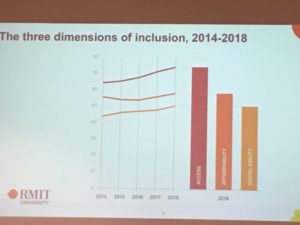
Kristin Alford – Designing Research Experiences in the Technology Museum
Alford introduced herself as an engineer who has worked in mining and thinks in processes, and that her experiences with dance and gymnastics have critically shaped her thinking as well. She reflected ruefully that she sees the same percentage of women in her classes now as when she was a student. She said she reads a lot of fiction to take her to different worlds and is a futurist who likes the possibilities that fiction provides.
Her talk focused on how the MOD (Museum of Discovery) (where the conference opening reception was held) was designed and intentionally wants to be different than a typical museum. She mentioned the focus on the future that other places have and that this could be something to strive for, such as how in Dubai they’re already planning for a 100-year anniversary rather than a short-term one. She asked how do we showcase science in a way that doesn’t privilege one way of knowing, that allows for Western and Indigenous and other knowledge. She said kids aren’t inspired by the ‘get a job’ rhetoric around learning STEM, so she wants MOD to be different. Giving people more science doesn’t necessarily lead to better understanding; thus, the recent shift to more narrative and story-based museum experiences (ex. Museum of Tomorrow in Brazil).
She mentioned Kevin Kelly as a futurist from Edge.org. She said the fact is that if you tell the public, come learn about cancer, or tell young people, come learn how to transform industry, they’re going to think they have better things to do with their Friday night. She specified that MOD is deliberately not doing educational outreach or programs. Its aim is to try to get people to think of themselves as people who like science, rather than overtly encouraging them to like science. She mentioned the current exhibit on pain informing people that 90% of chronic pain is from your brain expecting signals and not a real physical cause. Finally, she provided some statistics about responses to MOD. Over 9 out of 10 rate is as good or excellent, and they are getting 1 in 3 visitors from their target 15-25-year-old target demographic. Since it has just recently opened, it will be a while until they have more data on visitors.
One of the questions was about whether there is any evidence that visiting a cultural institution about science will have an impact on going into STEM, or that it’s influencing academics. There doesn’t seem to yet be evidence on this. Another question was about how they recruited the teens they had involved in the design studio and workshops, and she said she focused on local teachers with whom she already had contact.
Digital Humanities in the Era of Linkage, Impact, Engagement and Innovation
Joanne Tompkins – ARC-funded DH Research
Tompkins noted that DH projects have more partnerships with industry and as a sector, DH should apply for more Linkage and LIEF grants. One tip in applying is that because the decision panel for Linkage grants is made up of a general audience, the project needs to be able to be understood by laypeople.
Panel: Joanna Tompkins, Penelope Aitken, Katherine Bode, Richard Maltby, Hamish Maxwell-Stewart
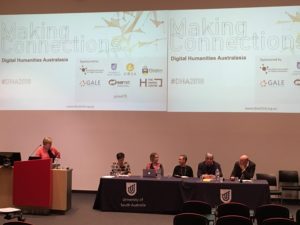 Aitken again urged academics to write outputs other than journal articles and believes it’s a skill that needs to be learned alongside traditional ones. Maltby called himself an occasional academic and observed that most people creating DH infrastructure are on short-term contracts (<2 years) even though sustainability is supposedly something that funders like ARC are concerned with.
Aitken again urged academics to write outputs other than journal articles and believes it’s a skill that needs to be learned alongside traditional ones. Maltby called himself an occasional academic and observed that most people creating DH infrastructure are on short-term contracts (<2 years) even though sustainability is supposedly something that funders like ARC are concerned with.
Maxwell-Stewart said that unfortunately, putting data in a data repository tends to kill it off, so partnering with industry is critical for getting people to use it (basically, it needs a public interface). He finds it challenging to find postgraduate students who have skills that he doesn’t that he needs to do research. He spoke of GIS, math, and computer science and a frightening skills gap in the humanities. He said those who do have certain technical skills can end up being stretched thin because they aren’t that many of them. Bode mentioned the gap between those considered academics and those considered professional staff. There was a comment about needing better postgraduate training in DH and a question about how to get more complex assessment, so students don’t have to write 80,000 words every time to show their learning. Maxwell-Stewart suggested that more data visualization would be helpful and that that is the future.
Birds of a Feather: Upskilling Approaches
This session was presented by Greg D’Arcy, an informatics specialist for HASS, and Nicole Laurent, a project archivist for the Find and Connect web resource, eScholarship Research Centre. Slides are available: go.unimelb.edu.au/ofc6. The context was that Chang et al.’s abstract for eResearch Australasia Conference shows that information professionals and library staff need expertise in lots of data-related skills. SCIP (scip.unimelb.edu.au) was designed to help break the ice for people who aren’t comfortable with digital stuff. They found there was a low response to ‘come learn about data visualization’, and that the just-in-time element was missing (many didn’t have their data ready). We know there is a lot of content out there (ex. YouTube), but it still needs to be packaged for students and it can be difficult when you’re working in isolation trying to learn stuff like Python. Another issue is that a lot of humanities researchers don’t see their data as data, and this can create discord when discussing it in that way with them. Learning with a purpose works well. There were questions about which tool to learn to start with (basically, whichever one is most relevant to the data you have and what you want to do with it, or what is used in your future career), what pitfalls there are to learning technology (having a learning group to collaborate with is helpful), and whether humanities researchers should do more to discuss their methodology to enable others to follow it in their research like scientists do (yes). The Future Humanities Workforce project in Australia was mentioned.
I didn’t attend the workshop with 3-D modeling of networks, but it looked fun, with LEGO and other craft materials used to make the models. 
